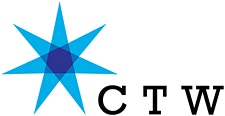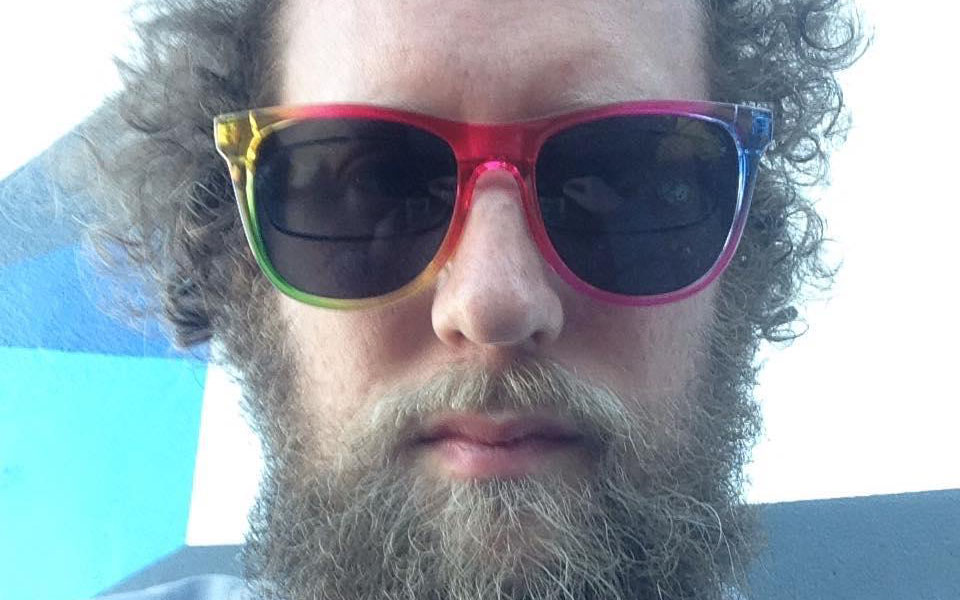Interview by Gary Shapiro
Gary Shapiro is a writer in New York.
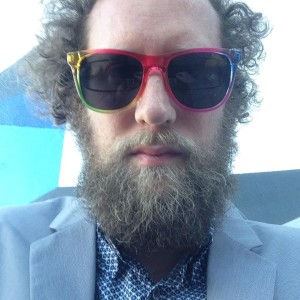
GS: What are you working on currently?
DT: I am working on the Straightened Trees project. I take large format photos of curvy trees and re-organize each image so that the tree is straight and perfectly centered. Using the tree as a spatial anchor, the human-made shapes in the background (e.g. buildings or power lines) lose their rigidity and take on the inverse of the curves of the tree, in a kind of exchange of forms.
This continues my work using computers to indulge or reinforce compulsive habits, and to create confrontations between human thinking and logical systems. However, it’s an unusual project for me because of the street photo aspect. I walk or drive around cities and suburbs across North America looking for trees I think might work visually in this treatment. It’s not actually that easy to find; in urban environments, most trees are not curved enough to make for a dramatic image. Sometimes I find a tree I am pretty sure will work well; these are rare enough that, for example, I once blocked a street in LA with my car to set up in the street to get the photo I wanted (which took a while, shooting 4×5 can be slow). However, I never really know how it’ll actually look until I’ve done the work of straightening it. This is a lengthy process, starting with Photoshop tools, then employing a program I wrote to make final adjustments. I’ve been working on this series since 2013 and am just now starting to finalize some images, it was slow to figure out the process.
Meanwhile, I’m continuing my investigations of programming languages as an art medium for my blog esoteric.codes. In addition to the research I do for the blog, I’ve continued my own programming language work, leading to a zine of my language work called New Languages. This includes work like my language Velato, where one writes code as a musical score, and 32 Variations in C++, a series of C++ dialects that mix formal computer language with aspects of human communication. It has a version of C++ that can only describe the past, and another where you identify with the compiler and express doubts about the program you’re constructing, which themselves continue to build the program.
GS: How did you get started in digital art?
DT: When I began my MFA at the International Center of Photography, I’d been working as a programmer for my day job for many years. At that point, I had digital projects that I was doing to learn programming. Something clicked in my first year of art school and I started to look at these projects exploring similar ideas I’d been looking at in my photography.
GS: I see that A.C. Lee wrote about your Borges bridge installation in the New York Times. Can you describe this project?
DT: BorgesLibrary.com is a collective word search, including all the words in Borges’s published writing. There are Spanish and English versions of the board. It is shown as a public work, projected last year on the Manhattan Bridge as part of Dumbo Arts Festival. As people find words and circle them on their own browsers — at home, or people walking by, selecting words on their mobile devices — the projection on the bridge updates and shows the most recently circled words. It can’t show the entirety of the board at once, as the board is far too large — so it zooms across to the most recent word circled. When people realized how this worked (it updates every 30 seconds), they would compete and try to get a word circled at the right moment so that the projection would zoom to their word.
During the weekend of Dumbo Arts Festival, 5933 new words were circled. After the Vice: Motherboard and New York Times pieces went live, there was so much traffic that I was concerned the Borges database would be overwhelmed, but it held together. More results from that event are HERE.
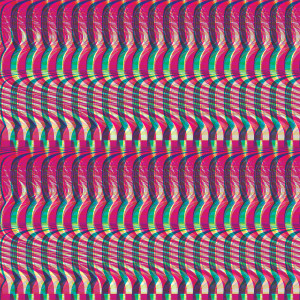
DT: It’s probably easiest to describe through the process of creating the works. I begin with a simple black shape on a white background, usually a circle, square, or triangle. I open the image in a sound editor, telling the program that it’s raw sound data. I manipulate the data by applying sound effects. I then re-open in Photoshop, and, after making contrast adjustments, decide whether I like the direction is going. If I do, I save it, re-open in the sound editor and continue, otherwise I go back a step. I do this over and over until the work feels complete. Often the result is a colorful, hallucinatory landscape.
If I were to try to design these images in Photoshop, I would never be able to do it. It’s only through bypassing conscious choices that I can create these. After doing this for many years, I have a vague sense of how each sound effect will transform the image, but it’s still different every time, due to differences in size, or which part of the image I’ve selected, etc. As Curt Cloninger puts it, it’s like “painting with a very blunt brush that has a mind of its own.” Sometimes I try the same set of steps that have produced a result I’ve liked previously. The great thing is that it’s always a new different piece at the end. It’s this sense of collaborating with the machine, of giving up control to a process too difficult to fully understand that draws me back to create more.
In variations of Glitchometry, I begin with black and white stripes rather than shapes, and limit these to types of sound effects that are less “noisy,” producing crisper images. In another variation, I use no sound at all, and simply re-open the image in the wrong size or resolution, breaking the image down into individual lines and patterns (these are black and white). By changing the constraints of the work, I end up with very different visual results.
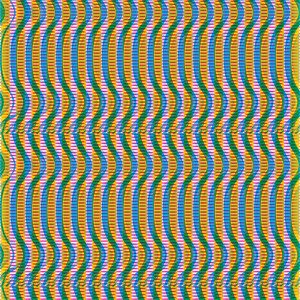
DT: I would put this a little differently now, to emphasize that communication does happen, despite our inability to control what it is exactly that we’re communicating. Computer languages are a great place to study how we bring more to language than we intend to, and carry more information than we are fully aware of. They are designed to communicate instructions to a machine, which discards gesture, affect, and connotation. We’ve been taught, since the time of Dijkstra’s The Humble Programmer (1972) to mute personal style in the interest of clarity. But connotation, gesture, etc. are so fundamental to how we communicate, it is difficult for them not to come out in how we code. My programming language work, such as Light Pattern, make these secondary meanings the most visible part of the code, often obscuring the code’s actual function, even if they are meaningless to the machine.
GS: Are galleries becoming more accepting of computer-related art?
Yes, although I prefer some resistance from galleries and collectors: Better to limit the market influence on digital work.
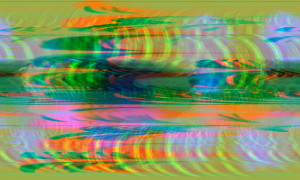
DT: I use computers as a place to explore our relationship with logic and compulsion, sometimes using the structure of code (often in the form of programming languages). In Light Pattern, my language uses photographs as code, the change of color plus change in aperture and shutter speed settings are translated into commands; they create the constraints that shape the Light Pattern programs. As Chris Pressey has pointed out about esoteric programming languages in general, none of this activity needs to happen on a computer. You can go out and shoot a series of photos in order to construct a Light Pattern program and never actually digitize them or use them with the LP compiler. The fact that they were constructed according to the rules of the language make them Light Pattern programs. Sometimes designing a language doesn’t involve actually writing code. The two languages that are the most widely coded in of mine are never coded in intentionally; one has only one possible program, which is identical to the first line of the Wikipedia entry on Programming Languages. Anyone who copies and pastes that sentence to their website has inadvertently written a program in my language. The other, called ? (a backwards C symbol), is made up of any invalid C or C++ program. Any failed C program is a valid program in my language; in fact any piece of text that is not valid C, including every question in this interview (whether or not it is digital), is a valid ? program, although the behavior of the programs are all left undocumented. This engagement with code hopefully carries over to work where like Straightened Trees, where we’re not actually looking at code when we experience the piece.
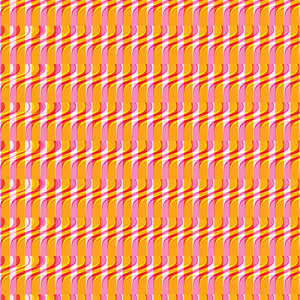
DT: My advice to young artists is to find or create the community of artists you respect. If you’re in New York, there are spaces like Higher Pictures, Transfer, Microscope, the New Museum’s NewInc incubator that each has a fantastic community of artists. If your work engages with text, the WordHack event at Babycastles each month is essential. One of the great things about making work online is that people who are not here and perhaps don’t have as strong a local community can connect online. I first met Hugh Manon, with whom I co-wrote Notes on Glitch on Flickr, and it wasn’t until years after our piece was published that we first met in person. Netart communities appear regularly online and inevitably die down after a few years, when new sites pop up with different takes on the medium. Right now I’m enjoying Newhive.com.
